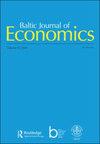Survey measures of inflation expectations in Poland: are they relevant from the macroeconomic perspective?
IF 0.8
3区 经济学
Q3 ECONOMICS
引用次数: 14
Abstract
ABSTRACT This paper estimates different versions of the stylized New Keynesian model of the Polish economy, in which alternative measures of inflation expectations are used, that is, model-consistent (rational) expectations and survey-based expectations of consumers, enterprises and financial sector analysts. To compare dynamic properties of the models, we analyse propagation of the interest rate impulse, exchange rate impulse and a permanent change of inflation target. Differences in impulse responses pose the question which model should be treated as the most adequate. Analysis of in-sample inflation forecasting errors suggests that the model with rational expectations displays the lowest forecasting accuracy, while the model using expectations of enterprises is the best-performing model. In more general terms, our analysis suggests the best way of exploiting survey data on inflation expectations is not by using them as separate forward-looking information, alternative to macroeconomic models, but by combining both types of information.波兰通胀预期的调查措施:从宏观经济角度看,它们是否相关?
本文估计了波兰经济风格化的新凯恩斯主义模型的不同版本,其中使用了通货膨胀预期的替代措施,即消费者,企业和金融部门分析师的模型一致(理性)预期和基于调查的预期。为了比较模型的动态特性,我们分析了利率脉冲、汇率脉冲和通货膨胀目标的永久变化的传播。脉冲响应的差异提出了一个问题,即哪种模型应被视为最适当的。样本内通货膨胀预测误差分析表明,具有理性预期的模型预测精度最低,而使用企业预期的模型预测精度最高。更一般地说,我们的分析表明,利用通胀预期调查数据的最佳方式不是将其作为单独的前瞻性信息,替代宏观经济模型,而是将两种信息结合起来。
本文章由计算机程序翻译,如有差异,请以英文原文为准。
求助全文
约1分钟内获得全文
求助全文

 求助内容:
求助内容: 应助结果提醒方式:
应助结果提醒方式:


